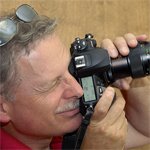
It's been coming for a while and now I see it's the only way I can go. I've no time to think, little time to compose, and the situation is never going to change. It's time dated. Short lived. Measured in minutes - not hours. Nothing can be repeated. Nobody waits for you. You work with what you have and must always be ready - until it's over.
What kind of situation is this?! Job interview? Tax audit? Oh, no - I'm talking about wedding photography!
Every location is new. Every customer is different. Every group of people is unpredictable. All of this is designed to test your preparedness and nerves, not to mention your manners.
Being in control of yourself is the key to success. The ceremony is predictable - cover every minute, literally. Shoot until people start looking at you funny. The family/friends group shots are cut and dried - you're in charge and they will turn out fine. But catching people in their most natural state and making good images of them can be two different things. (She's ugly. He doesn't smile. Will someone check their pulse, please?)
So, you put on the charm and coax them into a romantic mood with promises of fabulous photos for their efforts. If they believe you, there's a chance you'll get some shots even you will like. If not, they can't say you didn't try. Usually, something good happens and if you apply one of the aforementioned dictums, you will have a decent shot of even the worst subjects.
Are they all like that? Not at all. When the mood is festive, the location is engaging, and people are ready for the event, it can be a fantastic experience. But the rules don't change and you gotta come home with the goods. So, shooting voraciously is de rigeur. Don't stop and enjoy the moment - shoot it!
But more truly is better - a more picturesque location begs for creative coverage. Well dressed people are portrait practice potential. Attractive rooms become interior design challenges to show off the wedding decor. Late afternoon sun, the swimming pool, the dinner tent - each adds extra dimensions to what you can record - so do it quickly! Time is running out! Light is fading - people are moving. You are the only constant in this human drama. You're not there for the same reason they are. They will want to see this day again - and that's why they hired you.
Taking advantage of creative timeframes is a luxury. Most couples don't spend all day getting married like they use to. You get 3-5 hours to perform your miracles of modern photography and what you can cram in that space in time is all you get to work with. So revel in the opportunities to shoot in a garden after the ceremony and before the reception takes control of your time. Build in a half hour at a guaranteed location that will deliver cool personal images. You'll make a bigger fee, sure, but you'll feel even better for the images you gained.
All this is wrapped up in wedding photography - and it is a blast. You perspire. You improvise. You cajole the kids and compliment the bride's mother. All to get that elusive image that turns you on. Your images will tell the tale. You are a wedding photographer!











